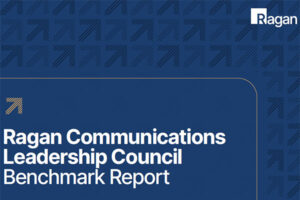2021 resolutions for internal communicators
As we enter a new year—bursting with possibilities and antibodies—let’s strive for healthier habits, professional development and meaningful personal progress.

Bidding adieu to 2020 is cathartic for many reasons—not least of which is that we all have a fresh start.
Regardless of what you endured last year, you can unwrap the shiny gift of a new beginning. How can you do your level best to make 2021 a smashing success—or at least markedly better than 2020? Here are a handful of resolutions to jot down to ensure you hit specific internal comms targets instead of wandering aimlessly.
1. Become your company’s chief people connector.
Internal communication is ultimately about building genuine relationships and understanding. It’s about connecting human beings in meaningful ways.
As the pandemic continues pushing us farther apart—physically and emotionally—you can play a crucial role in reversing your company’s growing social deficits. Social health is an essential spoke in the wheel of wellness, after all.
This is not to say you must found the Party Planning Committee or chair the Finer Things Club. But being more intentional about helping colleagues connect is perhaps the easiest way to become indispensable at your workplace. You’ll also get access to better data, uncover hidden stories and become a trusted, respected agent of inclusion.
In 2021, what’s stopping you from facilitating more consistent employee recognition? Is there any reason to not be the one who consistently offers praise for good work and checks in on colleagues? How about being the person who not only talks about knocking down siloes but who consistently bridges the gap between execs, HR, IT, marketing and frontline workers?
Becoming your company’s “chief people connector” should be at the top of your to-do list.
2. Learn new skills, such as podcasting and video.
It’s time to push yourself. Whether it’s becoming handier with graphics, braver with data, more confident while speaking on Zoom or more willing to tinker in your intranet’s CMS, this is the year to stretch outside that comfort zone. Many communicators would like to “do more video” or launch a podcast, but the mere thought of starting another “thing” can be daunting.
Paul Perry, who co-hosts Warren Averett’s “The Wrap” podcast, says communicators should consider a podcast to “help with spreading their culture, narrative and expertise within their industry for their clients (or prospective clients).” Podcasts can also be a boon for employee engagement, but their soft sales value should not be underestimated.
“People remember those who help them along the way through ideas, concerns and problem solving,” Perry says, which speaks to the notion that people still prefer doing business with trustworthy, likable personalities. If you’re not sure where to start, Perry says a podcast requires vision, value, volume and variety. He elaborates:
Vision: “Have a consistent theme for your podcast overall, including what you want people to think of when they think of your podcast,” Perry says.
Value: What benefit is your podcast adding to the business or offering your audience? Each episode and conversation should provide value, Perry says, noting that discussions should center on “actionable items” and takeaways that listeners can immediately put to use.
Volume: Perry says to invest in high-quality sound equipment, reputable software and a savvy producer. “No one wants to listen to you sound like you are in a tunnel,” he says. Even the most scintillating content can be rendered useless if your audio stinks, so make sure your recording is easy on the ears before publishing.
Variety: “Have some different conversations mapped out and provide a variety of content so listeners do not feel they are listening to the same conversation with each episode,” Perry says. He suggests setting an overall theme for each of your podcast seasons, such as answering employee or customer FAQs or “handling a crisis from different perspectives,” as Warren Averett recently did with its program.
If more video is on your docket for 2021 but you’re feeling shaky behind or in front of the camera, don’t fret. Jewelie Jukich, communication director for Alabev, says you don’t need tip-top equipment to get started. “You just need to do it!” she says.
Jukich says her teams has primarily used a Mevo camera paired with an iPhone as an external mic. She edits videos with Adobe Premiere Rush, which she notes is “phenomenal for editing on the go”—even on an iPhone. Her team has also used PowerPoint for screenshot videos and OneShot for iPhone, and each video is uploaded to Microsoft Stream and Microsoft Teams.
Ultimately, it’s about appealing to your audience, which means investing in personalization and segmentation. Jukich says her team used to ship one video to their entire sales team but found that information retention was low. To make the videos more relevant, she started segmenting the videos by topic but “found that still wasn’t specific enough.” Now, her team “creates a video for each individual team, which sometimes means up to 10 each month. The information each sales team gets is only relevant to them and their specific programming for the coming month. We also have a supporting PowerPoint they can reference that has our bullet points from the video.”
Jukich regularly meets with managers one-on-one to assess their needs and preferences, and she uses SurveyMonkey to gather employee feedback about the videos. One nugget she gleaned from surveys was that “information retention is higher when the team watches the video together rather than each member watching individually prior to their monthly meeting.” So, she now encourages area managers to play videos via Screen Share in Teams.
To further employees’ content personalization: “Each team has their own channel in Microsoft Teams and each channel has folders to separate monthly programs, incentives, pricing deals and companywide communication.”
And while upping your corporate video game is a fine 2021 resolution, Jukich offers a reminder that “video alone isn’t enough.” She says: “We will always have a one-sheeter or companion presentation and follow up via email or phone.”
3. Push for meaningful inclusion.
2021 is the year you must show your work on DE&I issues. However, don’t expect profound transformation overnight. Prioritize incremental change, and celebrate wins as your company honors commitments made in 2020. As Ayanna Robinson shares, companies should consider three simple yet pointed questions to take meaningful strides against systemic racism:
- Do your purpose and actions align with your public persona?
- Is your leadership team reflective of your public commitments?
- Are you planning for an inclusive future?
These questions should be at the forefront of communicators’ minds in 2021. Your resolutions should match accordingly.
Over to you, comms pros. What resolutions do you have for the new year?







